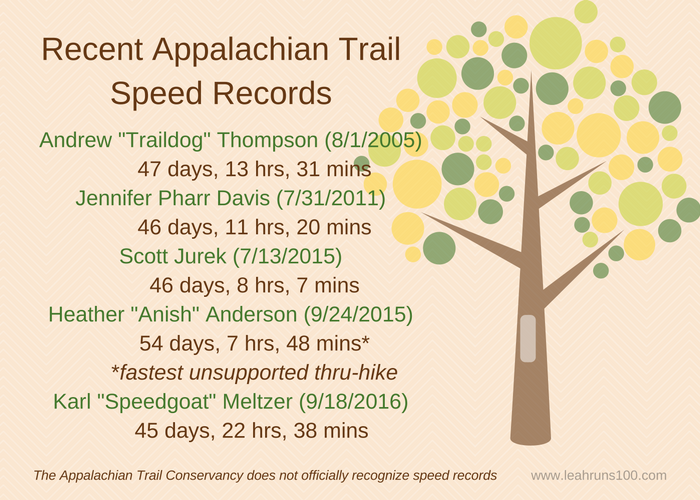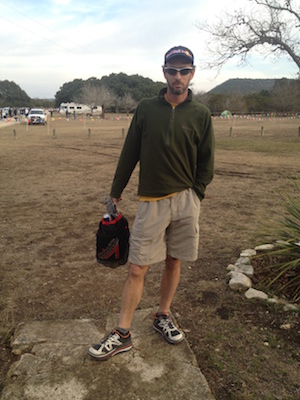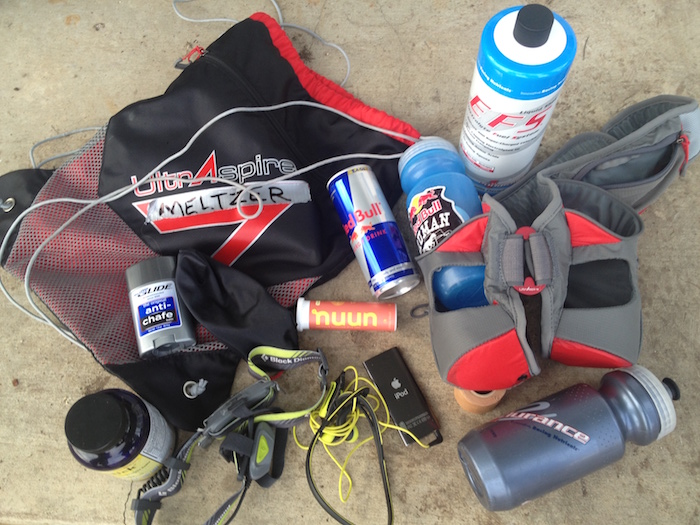Who doesn’t have some type of sports idol? And how many of us would swoon to hang with those admired elite athletes?
In trail running, those elites are at the local races, cheering in runners and working aid stations. They’re mingling with the masses, not segregated in a separate start group, clustered in a special VIP tent, or cordoned off behind security. Regular runners, like me, can hobnob with superstars.
It just so happens I’ve rubbed elbows with the last two thru-hikers, aka trail runners, to set the Appalachian Trail speed record: Scott Jurek (July 13, 2015) and Karl “Speedgoat” Meltzer (Sept. 18, 2016).

I first met Jurek at that ill-fated Rocky Raccoon 100 Miler (the icy Feb. 2011 race where I broke my ankle). My trail running friend Stephanie and I walking to packet pick-up; unfamiliar with Huntsville, we asked this tall, curly-headed guy and his friends for directions. A short chat ensued; when we went our separate ways, Stephanie and I turned to each other, breathlessly: “OMG, that was Scott Jurek, right?” (We crossed paths again at a 2012 book signing for his memoir/nutrition tome Eat & Run: My Unlikely Journey to Ultramarathon Greatness; whoever hasn’t returned my copy, you’re in trouble.)
After such superficial encounters, Jurek isn’t going to remember me–but Meltzer might. I interviewed him in Jan. 2013, before Tejas Trails’ Bandera 100K. Like any of the other trail runners, Meltzer was listening to the course talk, preparing drop bags, and hanging out after packet pick-up; we simply sat on a picnic table and talked.
At the time of our chat, Meltzer had already made one pass at the AT speed record (2008); he’d try again in 2014, but injuries would result in a DNF. And because trail running is full of genuinely supportive folks, Meltzer would also help pace Jurek in 2015 on his successful record-breaking AT thru-hike.
Meltzer now holds the record for fastest supported time to complete the 2,189 mile AT. And, yes, he did treat himself to a cold beer when finished.
Karl “Speedgoat” Meltzer Meets Bandera 100K
This article first appeared on February 7, 2013 at austinfitmagazine.com

In spite of the fact that the longest distance at the Bandera trail run is 100K, ultra runner Karl Meltzer was there in the Hill Country State Natural Area this January for the Tejas Trails event. For a guy whose blog subtitle is “100 Miles is Not That Far,” the 63-mile race, part of the Montrail Ultra Cup and 2013 USA 100KM Trail Championship, is just a warm-up.
Meltzer is a rock star in the ultrarunning community. An ultra is anything over the 26.2-mile length of the marathon, though the old timers will say that distances of less than 50 miles don’t quite get you into the club. None of this matters to Meltzer who, as of October 2012, has 34 100-mile wins on his resume. That is not a total; those are just the ones he’s won.
“Speedgoat” lives and trains in Sandy, Utah. He’s used to running on rocky, technical (trail runner speak for “challenging”) trails and quite likes to do so, and he was looking forward to experiencing what Bandera had to offer. Surprisingly, Meltzer had not run the course before, though he’d taken on the Rocky Raccoon 100 miler in Huntsville (much different terrain there: flat, soft, and sandy as opposed to the rolling hills and rocky, sotol-covered terrain of HCSNA). In his 40s, he’s a wiry guy with a fairly quiet demeanor about him, someone who’s easy to talk to and not interested in putting on airs or letting you know he’s the expert. Meltzer was a pretty good sport, too; he lugged a bag out so that AFM could take a look at the kind of stuff he packed, though he laughingly removed every trail runner’s staple, the compact Ziploc of toilet paper, saying, “We don’t really need to show that, do we?”

He’d been dealing with a peroneal nerve inflammation and, like many runners trying to work through an injury, he was simply hoping to finish (his predication was under ten hours, which he based on runners’ results from the past—he actually came in at 9:01, good enough for fourth place in a field where the course record was broken on a particularly hot, humid, and muddy day). “If I win,” Meltzer said jokingly, “I should just hang it up because I don’t need to work hard and train anymore.” Meltzer can run a 2:45 road marathon but roads really aren’t his “thing”; there’s something about that 100-mile distance off the asphalt that suits him spectacularly. The more technical, the better and he usually finds his second wind in the later half of races. Bandera was no exception.
Meltzer achieved some fame for two long distance endeavors that captured the imagination of those outside the trail running community: his attempt at breaking the Appalachian Trail record and completing the 2,064-mile Pony Express Trail.
In 2008, Meltzer undertook breaking the record for running the length of the Appalachian Trail, some 2, 176 miles, but foot problems, bad weather, and “Mother AT” conspired to keep him from his goal. He completed the trail in 54 days, 12 hours, and 12 minutes, still the fifth fastest finish time to date.
“I would love to go back to the Appalachian Trail,” Meltzer said wistfully. “It’s my favorite place to run. That kind of technical mountain trail is my love.”
His Pony Express Trail run covered the entire length of the famous route, spanning eight states. While the Pony Express is almost synonymous with the Old West, it actually only ran for 18 months (from April 1860–October 1861); what Meltzer did in 40 days, averaging 53 miles a day, took postal riders ten days. The big difference is theirs was no solo operation: 75 horses were needed, as a rider got a new horse every 10–15 miles, and a fresh rider came on every 75–100 miles (average speed was 10 mph).
In addition to racing and coaching, Meltzer puts on his own race, the Speedgoat 50K at the Snowbird Ski Resort in Utah (July 27), billed to be one of the toughest 31-mile races in the U.S. with 12,000 feet of climbing. Runners go up and down Mount Baldy some two and a half times, which makes it a great race for spectators, who can easily see runners at quite a few spots —not at all the norm for trail races. The run is part of the International Skyrunning Federation’s Ultra Cup and hands out some great prize money. Last year’s event brought stellar talent, though there was a bit of controversy over Kilian Jornet’s win. Race director Meltzer was put in the tough position of making a call regarding how to handle Jornet’s treatment of the course; he had cut switchbacks, something which can be done in European trail races but not on closed American courses. Meltzer modeled his decision over a Pikes Peak race with a similar circumstance, stripping Jornet of the prize money but allowing him to keep the win.

Meltzer’s direct ways can be refreshing; he doesn’t seem to be calculating what’s the best thing to say. Rather, he’s pretty honest and direct. At one point in our conversation, the topic of pacers came up and he stated flatly, “I don’t believe in pacers, and I don’t think anyone competing should get help.” A pacer in a trail race accompanies a runner in the longer miles (usually after 50 miles or once it gets dark), usually billed as a safety measure. Most races also specifically state that pacers cannot “mule” for their runners, which means that the pacer cannot help by carrying anything for the runner (one exception is the Leadville 100, which only states that pacers may not “push, pull, carry or tow the runner”).
Meltzer’s point is that a pacer is an aid and that muling happens unintentionally all the time. He himself does not utilize a pacer. He seems a pretty low maintenance runner, both from an equipment and crew standpoint. And Meltzer is clearly a fan of his sponsors’ products and not just mouthing the words; the man was drinking a Red Bull, wearing his Hokas (he runs in the lighter road version on the trail, an interesting idea), and carrying his UltraSpire bottles as he waited for the course talk to commence.
When Meltzer was asked if he had anything planned along the lines of the Pony Express Trail run, he shot a quick sideways glance and said, “Did you get wind of the new thing?” A quick comment from the Red Bull press crew, out there to support Meltzer during the run, assured him that no information had been leaked. Further pressed for hints, he said that there was something “secret in the works for Texas.”
One thing you can be certain of: whatever the event is, it’ll be a long way to run. And there will probably be a cold beer at the end for Speedgoat Karl.



